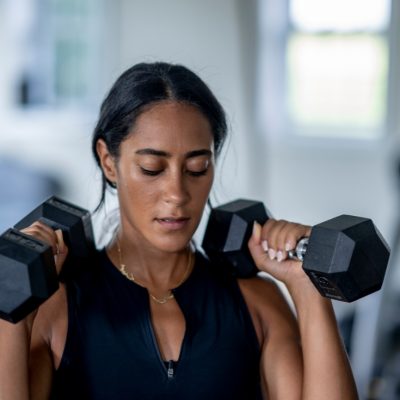
Strength training, also known as resistance training or weight training, is the most important thing women can do to maintain muscle after menopause.
As women transition through menopause one of the most significant, yet often overlooked changes, is the natural decline in muscle mass and strength. This process, known as sarcopenia, begins gradually in midlife but can accelerate after menopause due to decreasing estrogen levels. Estrogen is a hormone that plays a role in maintaining muscle tissue. This decrease in estrogen causes an increase in visceral fat mass or belly fat and decreases bone density as well as muscle mass and strength.
When women contact me after menopause their chief complaint is visceral fat, which is belly fat. Ladies that always had a small waist are now getting bigger around the middle, and it’s frustrating. I get it!
This shift in fat storage is largely due to the decrease in estrogen. But what else happens with these changes is muscle loss. Muscle loss leads to lower metabolism and ultimately weight gain. The good news is these changes are not totally inevitable, and there’s a lot you can do to stay strong and slim after the change. Muscle after menopause is something we need to be aware of and something we need to be focused on. What I tell my clients is to pick up the weights and build back the muscle you had before the change.
Muscle loss after menopause doesn’t just affect strength and weight-gain, it impacts balance, overall mobility and like I spoke of earlier, bone density. All of these factors will affect your independence as you age, so muscle is the most important thing we can focus on ladies. This can be done with progressive strength training, or weight training, this is key!
This type of progressive strength training has to be intentional. Muscle is lost fast and also takes time to gain. Be patient, consistent and plan to be progressive. You have to be safe but also progressive, increasing the weight as you get stronger. Progression means a little more intense, challenging yourself as you get stronger. I love to see the smiles on women’s faces when they increase their weights. It’s empowering, and I can see the change in them. I have had many clients shocked at how much they love it. I have found thirty minutes 2-3 times a week seems to really work for most ladies. They get it done and feel great after.
As a post-menopausal woman myself, I can vouch for the benefits of strength training to maintain muscle during this time of a woman’s life. Muscle after menopause is maintained with strength training. Period. It is that simple.
Of course there are other things you can do to keep muscle after menopause. Many of my ladies did not eat enough protein when I first started working with them. Adding more protein into your diet will help you to build and maintain that muscle. You will also benefit from a diet rich in protein and good fats. Stay away from sugars and processed foods. Increase your protein, you will need this for muscle building!
How to Preserve Your Muscle:
- Strength Training: Lifting weights is number one to maintain muscle after menopause. Add in other strength training exercises including bodyweight exercises, TRX or kettlebells. Strength train at least 2–3 times per week, this can preserve and rebuild muscle.
- Protein-Rich diet: Including meats, chicken, fish, eggs, whole milk organic plain yogurt and nuts to support muscle repair and growth.
- Stay Active: Daily movement including walking, climbing stairs, and gardening adds up.
- Sleep & Recovery: Muscles repair while you rest, so quality sleep matters. You should plan on going to sleep at the same time every night and try to get at least 8 hours of sleep a night.
How To Get Started:
I realize strength training can be intimidating for women. I have found in my 39 years of training women that many don’t know how to start. They are afraid of hurting themselves or intimidated by the gym atmosphere. Ladies, you need not be afraid. With the proper instruction you should not hurt yourself, in fact you will PROTECT yourself. Protect yourself as you age. Stay stronger, stay safer and stay slimmer! You will be empowered by what you are capable of. Do not let these perfect fit bodies on Instagram and Facebook intimidate. You are a woman that is powerful and able. Are we perfect? No. But we are able and all we need to do is start. Start with a 20 minute session to learn the basics. You can start in your living room with just a few body-weight exercises like squats and push-ups on a counter or back of your couch. Add in a few sets of dumbbells and a mat for the floor and you are on your way :).
Consistency Is Key:
Once you get started you have to keep going. You may be surprised and even enjoy it! Muscle will atrophy without consistent training. Make sure you keep motivated and schedule your strength training sessions into your day. Get up a half hour early or do it on your lunch break. Find a way, it is too important to not make time for.
Your Training Needs To Be Progressive:
The best way to build muscle no matter what your age is progressive strength training, or resistance training. This can be body weight exercises like squats, lunges or push-ups. It can be weight training with dumbbells or kettlebells. It can also be suspension training like the TRX, which is one of my favorite tools for home workouts. Check out my Blog on suspension training HERE.
Strength training can be fun with variety, but like consistency, your workouts will need to be progressive. This means as you get stronger you need to challenge yourself to progress to the next level. This means if you are using dumbbells or kettlebells you will progress to heavier weight as you get stronger. If you are using a TRX your angle will be harder or you may pause and hold to increase the intensity. Always progressing! You will read a lot of different views on this. My experience for the last 39 years working with women that are post-menopausal is you have to push yourself.
If it’s muscle after menopause you are looking for, light weights will not do. You will need to gradually increase your workout volume, weight, reps, and sets as your strength and endurance improves. This constant challenging will help you to build and maintain muscle after menopause!
A typical strength training program I would start my clients at would be:
- 10-14 exercises targeting all the major muscle groups
- each sets consists of 8-12 reps or until failure. If 12 reps is easy with good form we increase the weight or intensity.
- two or three workouts per week (30-45 minutes)
More On Protein:
Protein is made up of amino acids that are the building blocks of cells and tissue. There are nine of these amino acids that must be obtained through our diet. When we eat protein it is digested and broken down into these amino acids. We need protein for muscle growth and repair, because muscle tissue is continuously being broken down and rebuilt. To build muscle we need to consume more protein than what is broken down. So if you do not eat enough protein your body willl tend to break down the muscle you have, thus sarcopenia, or muscle wasting. We don’t want this ladies!
Some studies suggest that post-menopausal women may benefit from consuming higher amounts of protein, up to 1.4-2.2 grams per kilogram of body weight, to support muscle mass and prevent sarcopenia or muscle loss. To build muscle while strength training, eating protein with every meal is a must. Animal sources are best. Meat, chicken, eggs and yogurt from natural sources are your best bet. Stay away from processed foods, sugar and inflammatory vegetable oils. Eat real food when you can.
Takeaway:
Menopause marks a new chapter, but it doesn’t have to mean losing strength and gaining all that weight around your middle. Strength training is the answer to building muscle after menopause. Keep moving, lift weights and strength train 2-3 times a week. Don’t forget to get in quality protein and good sleep every day. With a proactive approach, you can keep your muscles, your health and independence strong for years to come. You’ve got this ladies.
Elissa XOXO





I have been working with Elissa for over 4 years
I am 73 and my upper arms look great. I ballroom dance and she has helped me with my strength and core
Thanks for commenting Barb! I appreciate your hard work and I’m glad you realize the importance of strength training. You are doing so well!
Wow! This is a great article with so much helpful information. Thanks for sharing all of this!
Hi Stephanie! Thank you so much and thanks for commenting! Elissa
This is great info. Thank you.
Thank you Amy! Thanks for commenting 🙂 Elissa